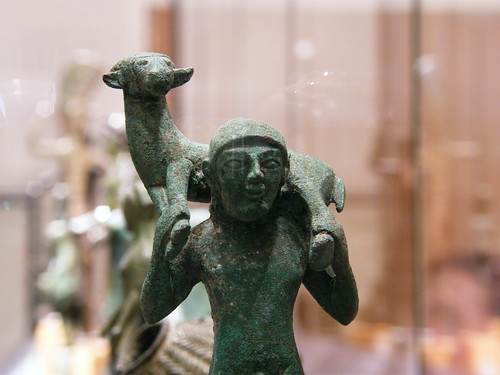I got a jump on the Queen of England the other day, and visited the newly-opened wing of the Ashmolean Museum of Art & Archaeology in Oxford a full week before she officially opens it Dec. 2. My parents live in Oxford, and I was visiting them unexpectedly (death in my husband’s family). They had tried to visit the Museum at the weekend, but queues that snaked round the block drove them back, so my father and I took a secondwalk over there on a quieter Wed. afternoonto see what all the fuss was about.
First off, I should confess that I haven’t set foot in the hallowed halls of the Ashmolean since my days as a dipsomaniac undergraduate at St. Edmund Hall, when the prospect of wandering around looking at a lot of dead old things was usually trumped heartily by the prospect of going to the pub. Walking in all anew 25 years later, I have to confess that the old parts of the museum seemed little more attractive to my more sober journalistic eye than they did then. My father and I agreed it all seemed a bit sombre.
The new wing, however, is a delight – brightly, beautifully lit, with elegantly beige walls and lots of raw wood on the floors, doors, benches, cabinets and so on. It has the aesthetic of a really upscale Japanese restaurant, which makes it welcoming and – most importantly for me – less draining on the energy reserves. I don’t know about you, but I find walking at museum-pace around vast echoing halls of marble, peering with polite interest into one glass cabinet after another to be tolerable only for an hour or so. Then a heaviness seems to gather in my lumbar region and I begin scanning for exit signs. I can’t be the only person who suffers from Museum Fatigue, because most modern or newly-renovated museums, such as this one, have a perfectly splendid cafe, restaurant, or bar tucked away somewhere. The Ashmolean is no exception and has a surprisingly swish combination of all three on the top floor, with a spectacular roof terrace attached that will be really useful in, err, oh, Oxford’s notional Spring and Summer or the odd day in February when it’s actually quite warm and sunny.
In any case, the energy drain is also ameliorated by the interactive stuff in the lovely basement area, which houses the conservation section. This is a new trend in museums – to let you look behind the curtain, as it were, and show you what the experts do all day. They haven’t gotten it quite right, but it’s a good try. A “touching” station invites you to touch various materials to show how even an innocent fingerprint can wear away stone and metal over time. But an impressively large digital display above the materials presented for touching merely measures how many times that piece has been touched since the wing opened. It would be much more interesting if you were shown an image of the oils your touch had left, or the change in acidity or conductivity, say. Other areas invite you to rearrange hieroglyphic-type symbols but don’t show you realEgyptian ones, which seems a shame. However, I don’t want to be too negative here. The new wing is a huge, huge improvement, and there’s a real sense of breaking the museum equivalent of the fourth wall referred to in theatre, when the actors interact with the audience. This is all to be applauded.
In particular, I admired the way that many of the displays are about people rather than things. Archaeology is full of flamboyantly odd characters, and it’s great to meet some of them here, including Arthur Evans, who gave us the Minoans in all their bull-jumping glory; and Sir John Myres, who was big on Cyprus. We even get a glancing reference to Agatha Christie, who cleaned ivories from Nimrud with her face cream and declared the delicate and wrong-headed task “thrilling”!
 The textiles are many, and colourful; the huge collection of ceramics on the second floor simply breathtaking. But my absolute favourite thing was in the basement. It was a reproduction of a statue of Augustus, painted as it might have been in Roman times, with gaudy blues and oranges. He looked like the gaudy symbol of power the citizen of Rome would have really looked up to.It’s one of my personal bugbears that statues and templesfrom Ancient Greece and Rome are presented in their denuded state of white marble and plaster. As a child, I believed our forefathers were terribly austere, and drifted around in an environment of towering, cold, whiteness. This, of course, is nonsense, but I bet most children (let alone adults) still labour under this misapprehension. If the new wing at the Ashmolean has done one worthwhile thing, it has gone some way to exploding this ridiculous myth that those who came before us weren’t just as tacky as we are.
The textiles are many, and colourful; the huge collection of ceramics on the second floor simply breathtaking. But my absolute favourite thing was in the basement. It was a reproduction of a statue of Augustus, painted as it might have been in Roman times, with gaudy blues and oranges. He looked like the gaudy symbol of power the citizen of Rome would have really looked up to.It’s one of my personal bugbears that statues and templesfrom Ancient Greece and Rome are presented in their denuded state of white marble and plaster. As a child, I believed our forefathers were terribly austere, and drifted around in an environment of towering, cold, whiteness. This, of course, is nonsense, but I bet most children (let alone adults) still labour under this misapprehension. If the new wing at the Ashmolean has done one worthwhile thing, it has gone some way to exploding this ridiculous myth that those who came before us weren’t just as tacky as we are.